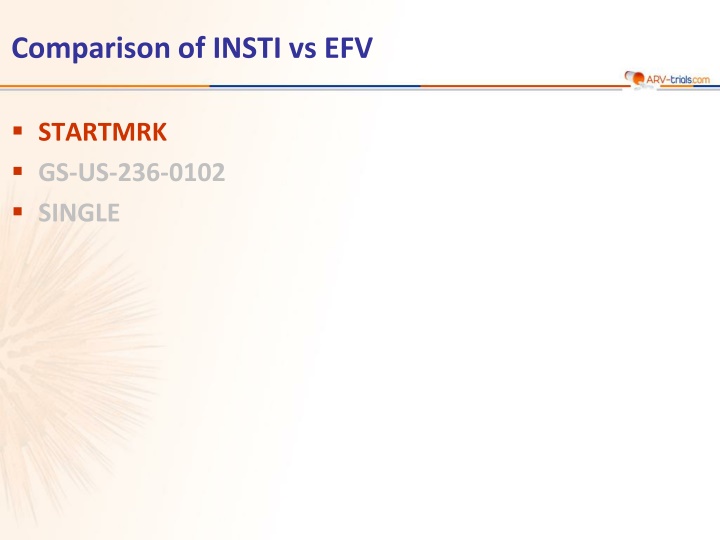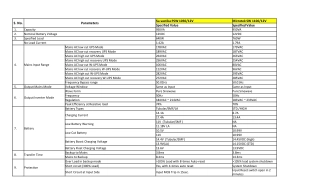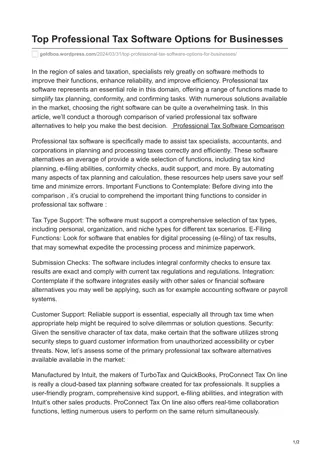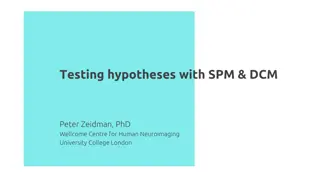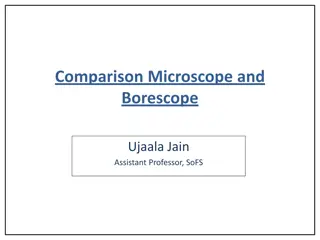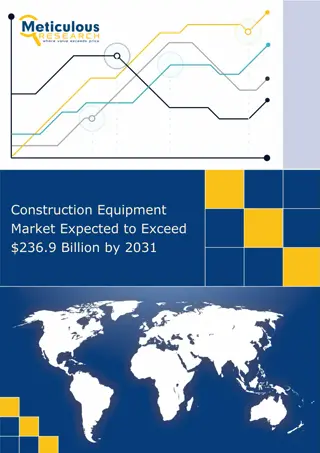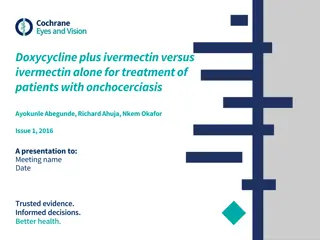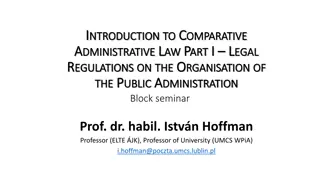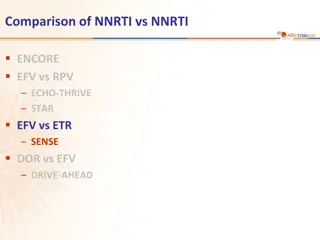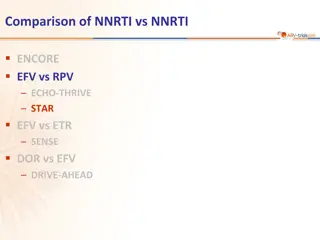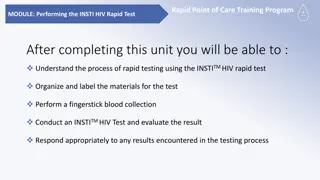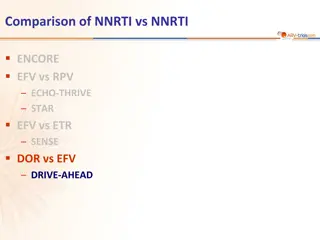Comparison of INSTI vs. EFV in STARTMRK GS-US-236-0102
In the STARTMRK study, Raltegravir (RAL) was compared to Efavirenz (EFV) in combination with TDF/FTC for the treatment of HIV. The study aimed to demonstrate non-inferiority of RAL compared to EFV in achieving HIV RNA levels below 50 c/mL. Baseline characteristics and patient disposition were assessed, along with response to treatment at week 48. RAL showed a significant increase in CD4/mm3 compared to EFV. Safety at week 48 was also evaluated, with RAL and EFV showing differences in clinical adverse events and drug-related AEs.
Download Presentation

Please find below an Image/Link to download the presentation.
The content on the website is provided AS IS for your information and personal use only. It may not be sold, licensed, or shared on other websites without obtaining consent from the author.If you encounter any issues during the download, it is possible that the publisher has removed the file from their server.
You are allowed to download the files provided on this website for personal or commercial use, subject to the condition that they are used lawfully. All files are the property of their respective owners.
The content on the website is provided AS IS for your information and personal use only. It may not be sold, licensed, or shared on other websites without obtaining consent from the author.
E N D
Presentation Transcript
Comparison of INSTI vs EFV STARTMRK GS-US-236-0102 SINGLE
STARTMRK Study: raltegravir vs efavirenz, in combination with TDF/FTC Design Randomisation* 1 : 1 Double-blind W48 W240 RAL 400 mg BID + EFV placebo N = 282 > 18 years ARV-na ve TDF/FTC fdc QD HIV RNA > 5,000 c/mL Any CD4 cell count No resistance to EFV, TDF or FTC EFV 600 mg QD + RAL placebo N = 284 TDF/FTC fdc QD *Randomisation was stratified by baseline HIV RNA (< or > 50,000 c/mL) and viral hepatitis co-infection status Objective Non inferiority of RAL vs EFV: % HIV RNA < 50 c/mL by per protocol, non- completer = failure analysis (lower margin of the 2-sided 95% CI for the difference = - 12%, 90% power) Lennox JL. Lancet 2009;374:796-806 STARTMRK
STARTMRK Study: raltegravir vs efavirenz, in combination with TDF/FTC Baseline characteristics and patient disposition RAL EFV Randomized, N Treated eligible patients, N Median age, years Female White/Black/Other HIV RNA (log10c/mL), median HIV RNA > 100,000 c/mL HIV RNA > 50,000 c/mL CD4 cell count (/mm3), median CD4 < 50 per mm3 HBsAg+ or HCV Ab+ Discontinuation by W48 For lack of efficacy For adverse event 282 281 37 19% 284 282 36 18% 41% / 12% / 47% 5.1 55% 72% 212 10% 6% 24 (8.5%) N = 4 N = 8 44% / 8% / 48% 5.0 51% 70% 204 11% 6% 35 (12.4%) N = 2 N = 17 RAL was administered with or without food, EFV on an empty stomach at bedtime, TDF/FTC in the morning with food Lennox JL. Lancet 2009;374:796-806 STARTMRK
STARTMRK Study: raltegravir vs efavirenz, in combination with TDF/FTC Response to treatment at week 48 HIV RNA < 50 c/mL RAL EFV HIV RNA < 50 c/mL at W48 (observed-failure analysis) by baseline factors % Primary analysis Per protocol, observed-failure * Baseline RAL EFV 100 91.6 89.1 86.1 81.9 RNA < 5 log10c/mL RNA > 5 log10c/mL 92.5% 90.9% 89.1% 89.2% 75 CD4 > 200/mm3 CD4 < 200/mm3 94.4% 88.3% 92.4% 85.6% 50 HIV-1 B subtype Non-B subtype 90.3% 96.3% 88.5% 90.9% 25 Mean CD4/mm3increase at W48 (observed-failure analysis): 189 (RAL) vs 163 (EFV) (P = 0.0184) N = 281 282 263 258 PP, NC = F 95% CI 95% CI for the difference = - 1.9; 10.3 for the difference = - 2.6; 7.7 * Exclusion of discontinuations due to intolerability or reasons unrelated to treatment Lennox JL. Lancet 2009;374:796-806 STARTMRK
STARTMRK Study: raltegravir vs efavirenz, in combination with TDF/FTC Safety at W48 RAL EFV P Clinical adverse events Drug-related AE Serious drug-related AE Treatment discontinuation due to AE Laboratory adverse events Drug-related AE Treatment discontinuation due to AE Clinical drug-related AE of moderate to severe intensity Headache Dizziness Insomnia Fatigue Diarrhoea No difference in incidence in other AE occurring in > 2% of patients Grade 3 or 4 laboratory abnormality Fasting LDL-cholesterol > 4.92 mmol/L (190 mg/dl) Incidence of other abnormalities < 2% and not different between arms 44.1% 1.4% 3.2% 77.0% 1.8% 6.0% < 0.0001 NS NS 5.0% 0 16% 4% 1% 4% 1% 1% 8.5% 0.4% 32% 5% 6% 3% 3% 3% NS NS < 0.0001 1% 4% Lennox JL. Lancet 2009;374:796-806 STARTMRK
STARTMRK Study: raltegravir vs efavirenz, in combination with TDF/FTC Safety: neuropsychiatric symptoms At Week 8 CNS-related adverse events had occurred in 10% of RAL patients vs 18% of EFV patients (P = 0.0149) Retrospective sensitivity analysis (additional symptoms): > 1 CNS-related adverse event: 20% vs 52% (P < 0.0001) Most symptoms were self-limited At Week 48 Cumulative incidence of CNS-related adverse event was significantly lower in patients on RAL: 14% vs 23% in the main analysis (P = 0.0044); 26% vs 59% in the sensitivity analysis (P < 0.0001) These events were generally mild: 62% of RAL vs 79% of EFV Only 1 patient, on EFV, discontinued the trial because of CNS-related adverse event Lennox JL. Lancet 2009;374:796-806 STARTMRK
STARTMRK Study: raltegravir vs efavirenz, in combination with TDF/FTC Cumulative treatment outcome for the entire 5 years study RAL N = 281 EFV N = 282 HIV RNA level < 50 c/mL 71.0% 61.3% Mean CD4/mm3change from baseline 374 312 Virologic failure (confirmed HIV RNA > 50 c/mL) 19.6% 20.9% Non response 3.6% 8.5% Rebound 16.0% 12.4% Death 5 (1.8%) 5 (1.8%) Discontinuation 71 (25.2% 98 (34.5%) Due to lack of efficacy 6 10 Due to clinical AE 14 25 Due to laboratory AE 0 3 Due to other reasons 51 60 Drug-related clinical adverse events 52.0% 80.1% Rockstroh JK, JAIDS 2013;63:77-85 STARTMRK
STARTMRK Study: raltegravir vs efavirenz, in combination with TDF/FTC Cumulative Discontinuation Rate due to AE (%) 20 18 RAL EFV 16 Log rank P-value = 0,023 14 12 10 8 6 4 2 0 0 16 32 48 60 72 84 96 120 140 168 192 216 240 Weeks Number at risk 281 272 265 262 255 246 236 231 227 223 217 190 282 272 257 254 245 235 221 213 203 200 196 183 Rockstroh JK, JAIDS 2013;63:77-85 STARTMRK
STARTMRK Study: raltegravir vs efavirenz, in combination with TDF/FTC Response to treatment at week 240 (5 years) HIV RNA < 50 c/mL RAL EFV HIV RNA < 50 c/mL (observed-failure analysis) by baseline factors % Per protocol, observed-failure * Primary analysis PP, NC = F Baseline RAL EFV 100 89.2 RNA < 5 log10c/mL RNA > 5 log10c/mL 94% 85% 78% 83% 80.7 71.0 75 CD4 > 200/mm3 CD4 < 200/mm3 82.5% 88.3% 78.7% 85.6% 61.3 50 HIV-1 B subtype Non-B subtype 90% 87% 79% 84% 25 Increases in fasting serum triglycerides, total cholesterol, HDL cholesterol, and LDL cholesterol from baseline were significantly lower at W240 (P < 0.005) in RAL than EFV N = 279 279 263 258 Difference (95% CI) = 9.5% (1.7 ; 17.3) Superiority Difference (95% CI) = 8.6% (1.9 ; 15.5) Superiority * Exclusion of discontinuations due to intolerability or reasons unrelated to treatment Rockstroh JK, JAIDS 2013;63:77-85 STARTMRK
STARTMRK Study: raltegravir vs efavirenz, in combination with TDF/FTC Cumulative summary of genotypicresistance data for patients with RNA > 400 c/mL at the time of virologic failure out to week 240 RAL N = 281 EFV N = 282 Protocol-defined virologic failure confirmed (HIV RNA > 50 c/mL) 55 (19.6%) 59 (20.9%) Resistance data available (HIV RNA > 400 c/mL) 23* 20 RAL or EFV resistance alone 1 7 RAL or EFV resistance, and NRTI resistance 3 3 NRTI resistance alone 3 2 * Integrase gene could not be amplified in 5 cases Emergence of RAL resistance in 4 patients (1.4%) Sequencing data of the 4 patients with emergence of RAL-associated mutations Q148H + G140S, Q148R + G140S, Y143Y/H + L74L/M + E92Q +T97A, Y143R Rockstroh JK, JAIDS 2013;63:77-85 STARTMRK
STARTMRK Study: raltegravir vs efavirenz, in combination with TDF/FTC Drug-related adverse events in > 5% in either group over 5 years RAL EFV Gastrointestinal disorders Diarrhea Flatulence Nausea General disorders Fatigue Nervous system disorders Dizziness Headache Somnolence Psychiatric disorders Abnormal dreams Insomnia Nightmare Skin and subcutaneous tissue disorders Rash 5.3% 3.6% 8.9% 9.9% 5.0% 11.0% 4.3% 8.9% 7.8% 9.3% 1.1% 35.1% 14.2% 7.4% 6.8% 7.5% 2.8% 13.1% 8.2% 5.3% 1.1% 8.2% Rockstroh JK, JAIDS 2013;63:77-85 STARTMRK
STARTMRK Study: raltegravir vs efavirenz, in combination with TDF/FTC Summary Conclusion At 48 weeks of treatment, RAL was non-inferior to EFV, in combination with TDF/FTC. Virologic non-inferiority of RAL was confirmed through W24. RAL was superior to EFV for virologic outcome at week 240 RAL + TDF/FTC led to more rapid viral load decline (significantly more patients with HIV RNA < 50 c/mL for weeks 2 to 16) Greater increase in CD4 was observed in the RAL group. It was significant from W156 Upon virologic failure, resistance mutations to RAL was found in few cases RAL was associated with significantly fewer overall and drug-related clinical adverse events, and CNS-related adverse events than was EFV Mean changes in lipid parameters were smaller for RAL than for EFV RAL + TDF/FTC is an alternative to EFV + TDF/FTC as a first-line combination regimen in treatment-na ve HIV-infected patients Lennox JL. Lancet 2009;374:796-806; Rockstroh JK, JAIDS 2013;63:77-85 STARTMRK
